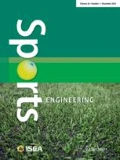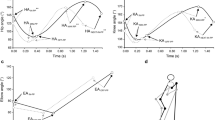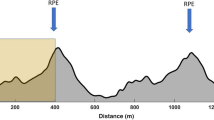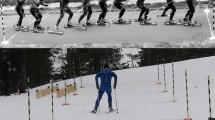Abstract
The forward skating start is a fundamental skill for ice hockey players, yet extremely challenging given the low traction of the ice surface. The technique for maximum skating acceleration of the body is not well understood. The aim of this study was to evaluate kinematic ice hockey skating start movement technique in relation to a skater’s skill level. A 10-camera motion capture system placed on the ice surface recorded “hybrid-V” skate start movement patterns of high and low calibre male ice hockey players (n = 7, 8, respectively). Participants’ lower body kinematics and estimated body centre of mass (CoM) movement during the first four steps were calculated. Both skate groups had similar lower body strength profiles, yet high calibre skaters achieved greater velocity; skating technique differences most likely explained the performance differences between the groups. Unlike over ground sprint start technique, skating starts showed greater concurrent hip abduction, external rotation and extension, presumably for ideal blade-to-ice push-off orientation for propulsion. Initial analysis revealed similar hip, knee and ankle joint gross movement patterns across skaters, however, further scrutiny of the data revealed that high calibre skaters achieved greater vertical CoM acceleration during each step that in turn allowed greater horizontal traction, forward propulsion, lower double-support times and, accordingly, faster starts with higher stride rates.









Similar content being viewed by others
References
Hamel J (2011) What is the maximum speed ice hockey players reach? https://www.quora.com/What-is-the-maximum-speed-ice-hockey-players-reach. Accessed 3 Mar 2016
NHL (2015) NHL Skills Competition All-Time Results, 1990–2012. http://www.nhl.com/ice/page.htm?id=67157. Accessed 3 Mar 2016
Marino G (1995) Biomechanics of power skating: past research, future trends. In: Proceedings of the XIII international symposium for biomechanics in sport, International Society for Biomechanics in Sport. Lakehead University, Thunder Bay, ON, pp 246–252
Lafontaine D (2007) Three-dimensional kinematics of the knee and ankle joints for three consecutive push-offs during ice hockey skating starts. Sports Biomech 6(3):391–406. doi:10.1080/14763140701491427
McPherson MN, Wrigley A, Montelpare WJ, Pearsall D, Ashare A (2004) The biomechanical characteristics of development-age hockey players: determining the effects of body size on the assessment of skating technique. In: Safety in ice hockey, pp 272–287
Shackel B (2008) A biomechanical comparison of starting technique in speed skating and hockey. M.Sc. thesis, University of Manitoba
Buckeridge E, LeVangie MC, Stetter B, Nigg SR, Nigg BM (2015) An on-ice measurement approach to analyse the biomechanics of ice hockey skating. PLoS One 10(5):e0127324. doi:10.1371/journal.pone.0127324
Dewan C, Pearsall D, Turcotte R (2004) Ankle kinematics during forward hockey skating: acceleration to constant velocity. In: International Society for the Biomechanics of Sport, pp 387–390
Zuiker T (2014) The effects of different speed skating push-off techniques on the mechanical power, power distribution and energy expenditure. Dissertation, Delft University of Technology
Upjohn T, Turcotte R, Pearsall DJ, Loh J (2008) Three-dimensional kinematics of the lower limbs during forward ice hockey skating. Sports Biomech 7(2):206–221. doi:10.1080/14763140701841621
Stidwill TJ, Pearsall D, Turcotte R (2010) Comparison of skating kinetics and kinematics on ice and on a synthetic surface. Sports Biomech 9(1):57–64
Stull JD, Philippon MJ, LaPrade RF (2011) “At-risk” positioning and hip biomechanics of the Peewee ice hockey sprint start. Am J Sports Med 39(Suppl):29S–35S. doi:10.1177/0363546511414012
de Koning J, Thomas R, Berger M, de Groot G, van Ingen Schenau G (1995) The start in speed skating: from running to gliding. Med Sci Sports Exerc 27(12):1703–1708
Chang R, Turcotte R, Pearsall D (2009) Hip adductor muscle function in forward skating. Sports Biomech 8(3):212–222. doi:10.1080/14763140903229534
Oxford Metrics Ltd (1999) Plug-in Gait. Oxford Metrics Ltd, Oxford
Ernst M, Götze M, Müller R, Blickhan R (2014) Vertical adaptation of the center of mass in human running on uneven ground. Hum Mov Sci 38:293–304. doi:10.1016/j.humov.2014.05.012
Myklebust H, Gloersen O, Hallen J (2015) Validity of ski skating center of mass displacement measured by a single inertial measurement unit. J Appl Biomech. doi:10.1123/jab.2015-0081
Baker R, Finney L, Orr J (1999) A new approach to determine the hip rotation profile from clinical gait analysis data. Hum Mov Sci 18(5):655–667. doi:10.1016/S0167-9457(99)00027-5
Robertson DGE, Dowling JJ (2003) Design and responses of Butterworth and critically damped digital filters. J Electromyogr Kinesiol 13(6):569–573. doi:10.1016/S1050-6411(03)00080-4
Dixon PC, Tisseyre M, Damavandi M, Pearsall DJ (2011) Inter-segment foot kinematics during cross-slope running. Gait Posture 33(4):640–644. doi:10.1016/j.gaitpost.2011.02.010
Zeni JA Jr, Richards JG, Higginson JS (2008) Two simple methods for determining gait events during treadmill and overground walking using kinematic data. Gait Posture 27(4):710–714. doi:10.1016/j.gaitpost.2007.07.007
Hreljac A, Marshall RN (2000) Algorithms to determine event timing during normal walking using kinematic data. J Biomech 33(6):783–786
Dixon PC, Loh JJ, Michaud-Paquette Y, Pearsall DJ (2016) biomechZoo: an open-source toolbox for the processing, analysis, and visualization of biomechanical movement data. Comput Methods Progr Biomed. doi:10.1016/j.cmpb.2016.11.007
Armstrong RA (2014) When to use the Bonferroni correction. Ophthalmic Physiol Opt 34(5):502–508. doi:10.1111/opo.12131
Grieve AP (1984) Tests of sphericity of normal distributions and the analysis of repeated measures designs. Psychometrika 49(2):257–267. doi:10.1007/bf02294176
Saibene F, Minetti AE (2003) Biomechanical and physiological aspects of legged locomotion in humans. Eur J Appl Physiol 88(4–5):297–316
Nagahara R, Matsubayashi T, Matsuo A, Zushi K (2014) Kinematics of transition during human accelerated sprinting. Biol Open 3(8):689–699. doi:10.1242/bio.20148284
Marino G (1983) Selected mechanical factors associated with acceleration in ice skating. Res Q Exerc Sport 54(3):234–238
Owings TM, Grabiner MD (2004) Step width variability, but not step length variability or step time variability, discriminates gait of healthy young and older adults during treadmill locomotion. J Biomech 37(6):935–938. doi:10.1016/j.jbiomech.2003.11.012
Arellano CJ, Kram R (2011) The effects of step width and arm swing on energetic cost and lateral balance during running. J Biomech 44(7):1291–1295. doi:10.1016/j.jbiomech.2011.01.002
Pearsall D, Turcotte R, Lefebvre R, Bateni H, Nicolaou M, Montgomery D, Chang R (2001) Kinematics of the foot and ankle in forward ice hockey skating. In: ISBS-conference Proceedings archive, vol 1
Stidwill T, Turcotte R, Dixon P, Pearsall D (2009) Force transducer system for measurement of ice hockey skating force. Sports Eng 12(2):63–68. doi:10.1007/s12283-009-0033-4
Bruening DA, Richards JG (2006) The effects of articulated figure skates on jump landing forces. J Appl Biomech 22(4):285
Acknowledgements
This work was financially supported by the Natural Sciences and Engineering Research Council of Canada (NSERC) under [Grant Number CRDPJ 453725-13]; as well as Bauer Hockey Corp. The authors would like to thank Adrien Gerbé and Spencer Paveck for their help during the data collection process.
Author information
Authors and Affiliations
Corresponding author
Ethics declarations
Conflict of interest
The authors declare that they have no conflict of interest.
Rights and permissions
About this article
Cite this article
Renaud, P.J., Robbins, S.M.K., Dixon, P.C. et al. Ice hockey skate starts: a comparison of high and low calibre skaters. Sports Eng 20, 255–266 (2017). https://doi.org/10.1007/s12283-017-0227-0
Published:
Issue Date:
DOI: https://doi.org/10.1007/s12283-017-0227-0




